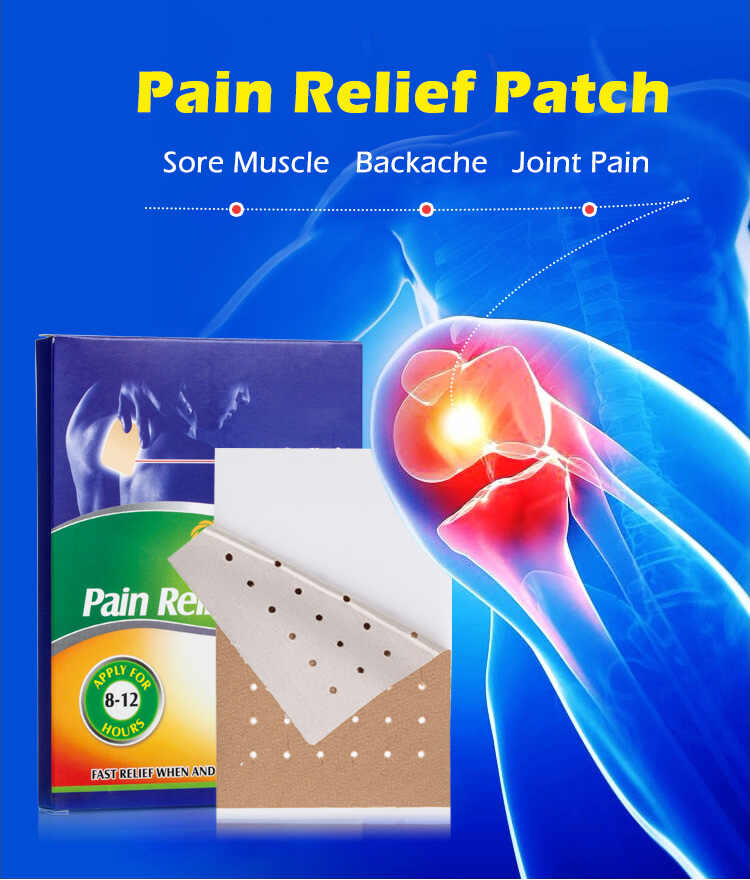Are Pain Relief Stickers Safe for Regular Use?
Pain relief stickers, also known as transdermal patches, are increasingly becoming a popular choice for individuals seeking non-invasive solutions for managing chronic or acute pain. These patches are easy to apply, discreet, and provide continuous pain relief over extended periods. However, as with any health-related product, one of the most common questions that arise is: Are pain relief stickers safe for regular use?
In this article, we will explore the safety concerns surrounding Pain Relief Stickers, including their ingredients, potential side effects, and how regular use might affect long-term health. Additionally, we will examine the role of Pain Relief Sticker Manufacturers, Pain Relief Sticker OEM partnerships, and how customizing Pain Relief Stickers for your brand can influence safety and efficacy.

What Are Pain Relief Stickers?
Pain relief stickers are adhesive patches that contain active ingredients designed to relieve pain through the skin. These patches are typically infused with compounds such as menthol, capsaicin, lidocaine, or other analgesics. The patches work by releasing these ingredients gradually over time, allowing for long-lasting relief without the need for oral medications.
Many consumers choose Pain Relief Stickers because they offer localized pain relief with minimal risk of gastrointestinal side effects, which can occur with oral pain relievers. Furthermore, they are easy to apply and remove, making them a convenient option for those suffering from conditions like arthritis, muscle soreness, or sports injuries.
How Do Pain Relief Stickers Work?
Pain relief stickers function through the process of transdermal delivery, where the active ingredients penetrate the skin and enter the bloodstream or target the affected area directly. This method bypasses the digestive system, reducing the likelihood of systemic side effects that can come from oral pain medications.
The active ingredients in pain relief stickers are designed to provide continuous relief for several hours or even up to a day, depending on the formulation and the patch’s design. For example, a Custom Pain Relief Sticker may be formulated to deliver a specific dosage of menthol or capsaicin, which work by soothing the nerves and reducing inflammation in the muscles or joints.
Are Pain Relief Stickers Safe for Regular Use?
1. Ingredient Safety
The safety of Pain Relief Stickers largely depends on the active ingredients used in the product. Common ingredients found in pain relief stickers include menthol, camphor, lidocaine, and capsaicin. Let’s take a closer look at each:
Menthol: This is a common ingredient in many over-the-counter pain relief products. It works by creating a cooling sensation that helps to mask pain and soothe inflammation. Menthol is generally safe for most people, but individuals with sensitive skin may experience irritation or allergic reactions.
Capsaicin: Derived from chili peppers, capsaicin helps to reduce pain by blocking certain pain receptors in the body. It can cause a warming sensation on the skin, which is typically safe, but prolonged or frequent use can lead to skin irritation or burning sensations.
Lidocaine: A local anesthetic, lidocaine numbs the area where it is applied, providing relief from pain. Lidocaine is safe when used as directed, but overuse can lead to skin reactions, or, in rare cases, systemic side effects such as dizziness or confusion.
2. Skin Irritation and Allergic Reactions
The adhesive and active ingredients in Pain Relief Stickers may cause skin irritation or allergic reactions in some individuals. For example, sensitive skin may react negatively to the adhesive used in the patches, leading to redness, itching, or rashes.
Before using any Private Label Pain Relief Sticker, it’s important to perform a patch test, especially for those with sensitive skin or known allergies to ingredients like menthol or capsaicin. It’s also important to follow the manufacturer's instructions regarding the duration of use and whether or not the patch should be applied to broken or irritated skin.
3. Frequency of Use
While pain relief stickers are designed for convenient, long-lasting pain management, they should not be overused. Regular application of pain relief patches, especially those containing ingredients like menthol or capsaicin, could lead to skin tolerance or irritation. Most Pain Relief Sticker Suppliers recommend limiting the use of a single patch to 8–12 hours a day, depending on the specific product.
In cases where Pain Relief Stickers are used frequently, it’s crucial to allow the skin to "rest" between applications. Overuse could cause cumulative irritation, which could potentially lead to more severe skin issues over time. It’s also important to rotate the areas where the patch is applied to avoid prolonged exposure to the same skin.
4. Long-Term Effects
There is limited evidence on the long-term effects of using Pain Relief Stickers regularly. Since these products typically contain ingredients like menthol, capsaicin, or lidocaine, which are generally considered safe for short-term use, the primary concerns with long-term use are related to skin health.
Using these patches excessively may lead to chronic skin irritation, sensitivity, or even thinning of the skin over time. However, when used in moderation and according to manufacturer instructions, most users do not experience significant long-term side effects.
5. Safety for Specific Populations
While Pain Relief Stickers are safe for most adults, caution should be exercised when using these products for certain populations:
Pregnant or Breastfeeding Women: Some ingredients, such as lidocaine, may not be recommended for use during pregnancy or breastfeeding. Always consult a healthcare provider before using any pain relief products during pregnancy or lactation.
Children: Many Pain Relief Sticker Manufacturers advise against using pain relief patches for children under a certain age due to the potential for skin irritation and the risk of incorrect dosage.
Individuals with Pre-existing Conditions: People with skin conditions such as eczema, psoriasis, or open wounds should avoid applying Pain Relief Stickers directly to affected areas to avoid further irritation or adverse reactions.
How to Choose Safe Pain Relief Stickers for Regular Use
When choosing a Pain Relief Sticker for regular use, it’s important to consider the following factors:
Quality of Ingredients: Choose products from reputable Pain Relief Sticker Manufacturers that use high-quality, tested ingredients. Opt for products that have been dermatologically tested and are free of harmful chemicals.
FDA Approval: For medical-grade products, ensure that the pain relief sticker is FDA-approved or compliant with local regulations. This ensures that the product has undergone safety testing and is fit for consumer use.
Customization and Branding: If you are sourcing Custom Pain Relief Stickers for your business, make sure the Pain Relief Sticker OEM you partner with adheres to high manufacturing standards, including compliance with health and safety regulations.
Consumer Reviews and Feedback: Always check customer reviews and feedback before purchasing or offering a product. If the product has received a lot of complaints about irritation or side effects, it may not be the best choice for long-term use.
Conclusion
In conclusion, Pain Relief Stickers are generally safe for regular use when applied according to the manufacturer's guidelines. They provide an effective, non-invasive way to manage pain, but overuse or improper application can lead to skin irritation or other side effects. Always ensure that you are using high-quality products from reputable Pain Relief Sticker Suppliers or Pain Relief Sticker Manufacturers, and consult with a healthcare provider if you have concerns about long-term use.
By understanding the ingredients, potential side effects, and proper application methods, you can ensure that your use of pain relief stickers remains both safe and effective.
Related Questions and Answers
Are Pain Relief Stickers safe for daily use?
Yes, pain relief stickers are generally safe for daily use if applied correctly and according to the manufacturer's instructions. Overuse can lead to skin irritation or other adverse reactions.
Can Pain Relief Stickers cause allergic reactions?
Yes, some individuals may experience allergic reactions to the ingredients or adhesive in pain relief stickers. It’s recommended to conduct a patch test before regular use.
How often can I use Pain Relief Stickers?
Most Pain Relief Sticker Suppliers recommend using the patches for 8–12 hours a day. Avoid applying the patch to broken or irritated skin.
Are Pain Relief Stickers safe for children?
Pain relief stickers are generally not recommended for young children. Always check the manufacturer's guidelines and consult a doctor if you're considering using them for children.
Can Pain Relief Stickers be used during pregnancy?
Some ingredients in Pain Relief Stickers, like lidocaine, may not be safe during pregnancy. Consult a healthcare provider before using any pain relief products during pregnancy.






